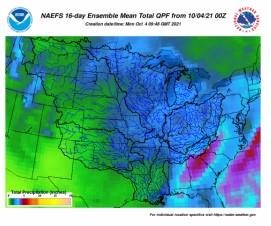By Jim Noel
After a brief period of wetness to start October, harvest season looks pretty good.

October temperatures will be well above normal. Rainfall will average close to normal after the brief wetter period this week.
https://www.cpc.ncep.noaa.gov/products/predictions/long_range/lead14/
The result will be that the first freeze date will likely be later than normal from October into early November.
As we head into the later part of harvest season beyond October, the warmer than normal weather will likely persist into November and possibly December. Rainfall will average close to normal. Some rainfall enhancement could develop later this fall near Lake Erie though with the warmer than normal lake waters.
https://www.cpc.ncep.noaa.gov/products/predictions/long_range/seasonal.php?lead=1
For the winter, we expect a warmer than normal start with a trend toward normal or slightly colder than normal finish. Precipitation is likely to increase to above normal as we go through winter.
https://www.cpc.ncep.noaa.gov/products/predictions/long_range/seasonal.php?lead=3
You can stay up-to-date on all the seasonal risks at the OHRFC websites: https://www.weather.gov/ohrfc/SeasonalBriefing
Over the next two weeks we expect 0.75 to 1.75 inches of rain across the state with isolated lower and higher totals as seen in the attached image.
Source : osu.edu